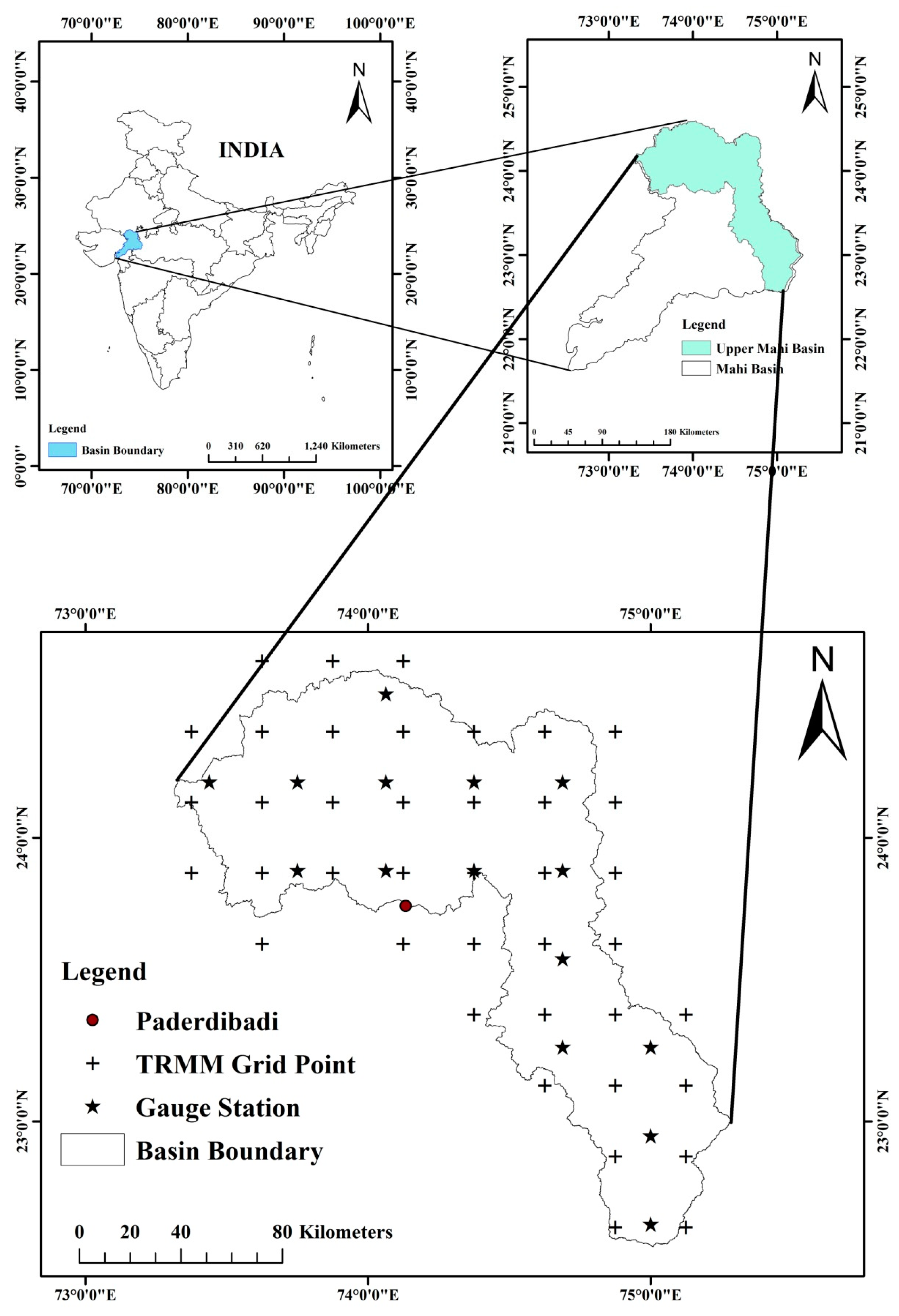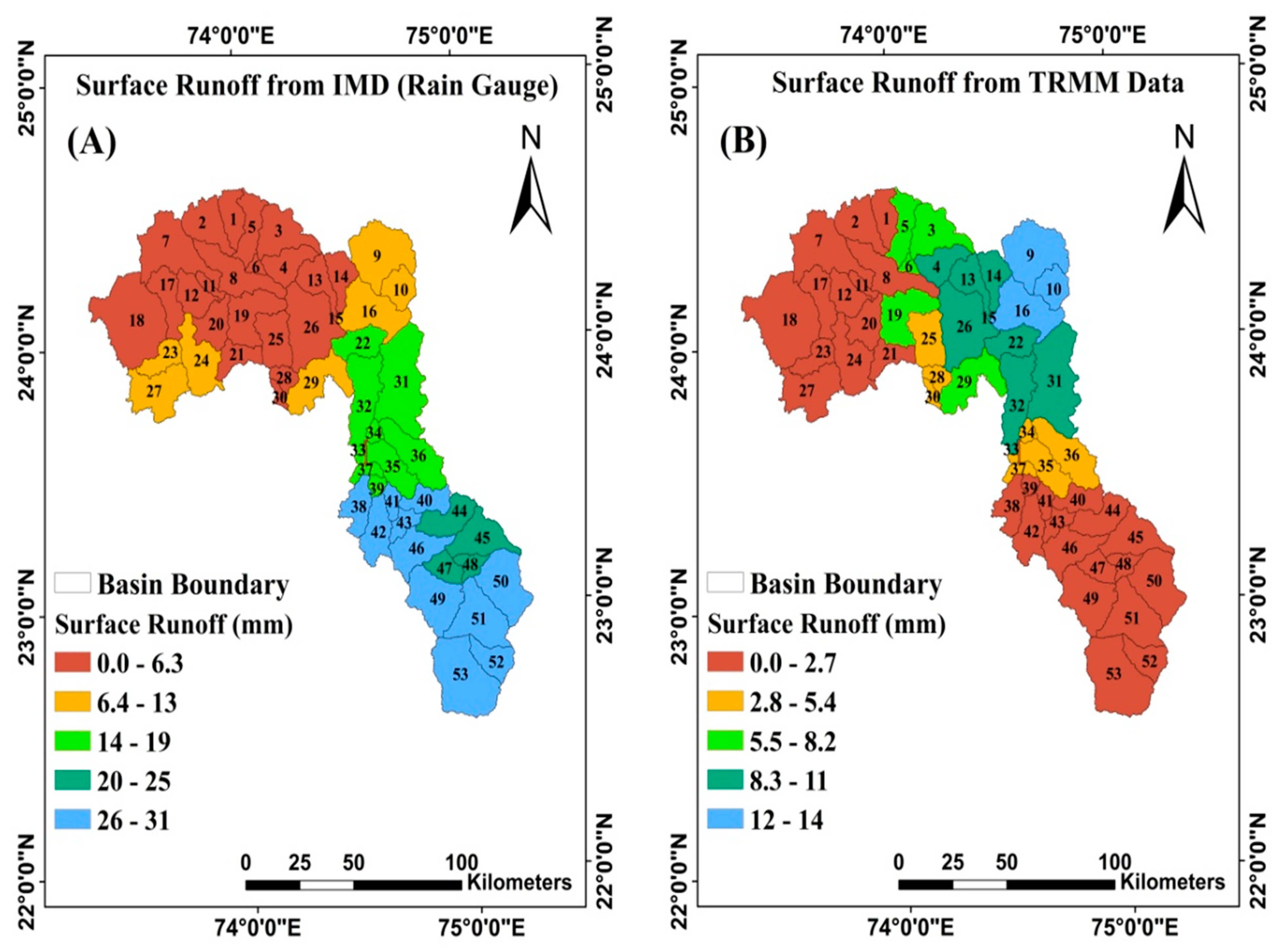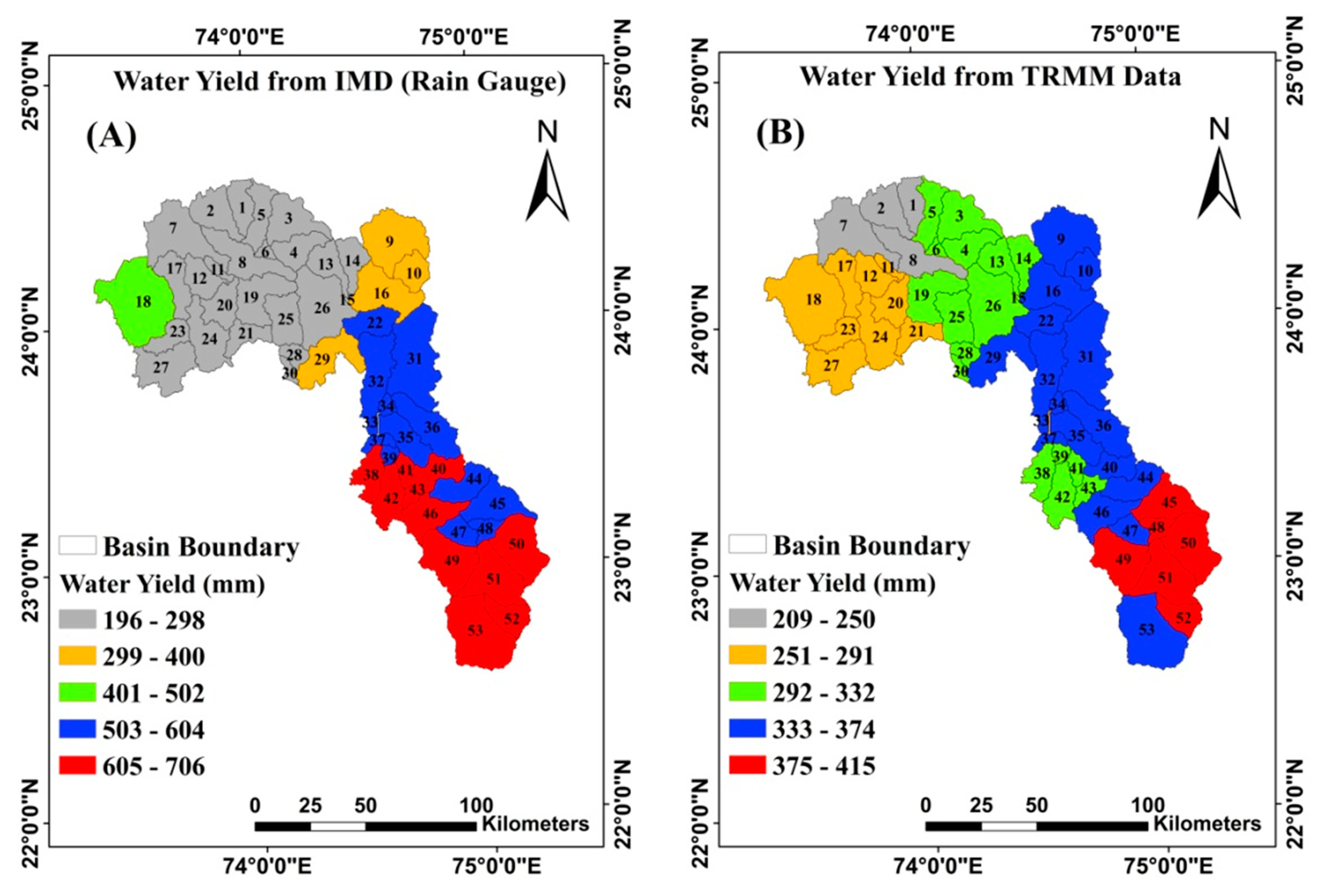Application of Satellite-Based and Observed Precipitation Datasets for Hydrological Simulation in the Upper Mahi River Basin of Rajasthan, India
Abstract
:1. Introduction
2. Description of Study Area
3. Data and Methodology
3.1. Discharge and Meteorological Data
3.2. Physical Data
3.3. SWAT Model Description
3.4. SWAT-CUP Model (SUFI-2 Algorithm)
3.5. Statistics Used for Performance Evolution
4. Results and Discussion
4.1. Comparison between Rain Gauge and TRMM Data
4.2. Calibration, Validation and Sensitivity Analysis
4.3. Intercomparison of IMD and TRMM Precipitation Impact on Hydrology
5. Conclusions
Author Contributions
Funding
Institutional Review Board Statement
Informed Consent Statement
Data Availability Statement
Conflicts of Interest
References
- Almazroui, M.; Saeed, F.; Saeed, S.; Islam, M.N.; Ismail, M.; Klutse, N.A.B.; Siddiqui, M.H. Projected Change in Temperature and Precipitation Over Africa from CMIP6. Earth Syst. Environ. 2020, 4, 455–475. [Google Scholar] [CrossRef]
- Council, N.R. NOAA’s Role in Space-Based Global Precipitation Estimation and Application; National Academies Press: Washington, DC, USA, 2007. [Google Scholar]
- Clemens, M.; Bumke, K. A comparison of precipitation in-situ measurements and model predictions over the Baltic sea area. Phys. Chem. Earth Part B Hydrol. Oceans Atmosphere 2001, 26, 437–442. [Google Scholar] [CrossRef] [Green Version]
- Valipour, M.; Bateni, S.; Sefidkouhi, M.G.; Raeini-Sarjaz, M.; Singh, V. Complexity of Forces Driving Trend of Reference Evapotranspiration and Signals of Climate Change. Atmosphere 2020, 11, 1081. [Google Scholar] [CrossRef]
- Jensen, N.; Pedersen, L. Spatial variability of rainfall: Variations within a single radar pixel. Atmos. Res. 2005, 77, 269–277. [Google Scholar] [CrossRef]
- Upadhyaya, S.; Ramsankaran, R. Review of Satellite Remote Sensing Data Based Rainfall Estimation Methods. Proceedings of HYDRO 2013 INTERNATIONAL, Chennai, India, 4–6 December 2013. [Google Scholar]
- Tapiador, F.J.; Turk, F.; Petersen, W.; Hou, A.Y.; García-Ortega, E.; Machado, L.A.; Angelis, C.F.; Salio, P.; Kidd, C.; Huffman, G.J.; et al. Global precipitation measurement: Methods, datasets and applications. Atmos. Res. 2012, 104–105, 70–97. [Google Scholar] [CrossRef]
- Kummerow, C.; Barnes, W.; Kozu, T.; Shiue, J.; Simpson, J. The Tropical Rainfall Measuring Mission (TRMM) Sensor Package. J. Atmos. Ocean. Technol. 1998, 15, 809–817. [Google Scholar] [CrossRef]
- Ebert, E.; Janowiak, J.E.; Kidd, C. Comparison of Near-Real-Time Precipitation Estimates from Satellite Observations and Numerical Models. Bull. Am. Meteorol. Soc. 2007, 88, 47–64. [Google Scholar] [CrossRef] [Green Version]
- Fereidoon, M.; Koch, M.; Brocca, L. Predicting Rainfall and Runoff Through Satellite Soil Moisture Data and SWAT Modelling for a Poorly Gauged Basin in Iran. Water 2019, 11, 594. [Google Scholar] [CrossRef] [Green Version]
- Daneshvar, F.; Frankenberger, J.R.; Bowling, L.C.; Cherkauer, K.A.; Moraes, A.G.d.L. Development of Strategy for SWAT Hydrologic Modeling in Data-Scarce Regions of Peru. J. Hydrol. Eng. 2021, 26, 05021016. [Google Scholar] [CrossRef]
- Tobin, K.J.; Bennett, M.E. Using SWAT to Model Streamflow in Two River Basins With Ground and Satellite Precipitation Data. JAWRA J. Am. Water Resour. Assoc. 2009, 45, 253–271. [Google Scholar] [CrossRef]
- Li, D.; Christakos, G.; Ding, X.; Wu, J. Adequacy of TRMM satellite rainfall data in driving the SWAT modeling of Tiaoxi catchment (Taihu lake basin, China). J. Hydrol. 2018, 556, 1139–1152. [Google Scholar] [CrossRef]
- Odusanya, A.E.; Mehdi, B.; Schürz, C.; Oke, A.O.; Awokola, O.S.; Awomeso, J.A.; Adejuwon, J.O.; Schulz, K. Multi-Site Calibration and Validation of SWAT with Satellite-Based Evapotranspiration in a Data-Sparse Catchment in Southwestern Nigeria. Hydrol. Earth Syst. Sci. 2019, 23, 1113–1144. [Google Scholar] [CrossRef] [Green Version]
- Lal, P.; Prakash, A.; Kumar, A. Google Earth Engine for concurrent flood monitoring in the lower basin of Indo-Gangetic-Brahmaputra plains. Nat. Hazards 2020, 104, 1947–1952. [Google Scholar] [CrossRef] [PubMed]
- Lal, P.; Prakash, A.; Kumar, A.; Srivastava, P.K.; Saikia, P.; Pandey, A.; Srivastava, P.; Khan, M. Evaluating the 2018 extreme flood hazard events in Kerala, India. Remote. Sens. Lett. 2020, 11, 436–445. [Google Scholar] [CrossRef]
- Huffman, G.J.; Adler, R.F.; Stocker, E.; Bolvin, D.T.; Nelkin, E.J. Analysis of TRMM 3-Hourly Multi-Satellite Precipitation Estimates Computed in Both Real and Post-Real Time. In Proceedings of the 12th Conference on Satellitle Merorology and Oceanography, Long Beach, CA, USA, 9–13 February 2003. [Google Scholar]
- Spruill, C.A.; Workman, S.R.; Taraba, J.L. Simulation of daily and monthly stream discharge from small watersheds using the swat model. Trans. ASAE 2000, 43, 1431–1439. [Google Scholar] [CrossRef]
- Dos Santos, J.Y.G.; da Silva, R.M.; Neto, J.G.C.; Montenegro, S.M.G.L.; Santos, C.; Silva, A.M. Assessment of land-use change on streamflow using GIS, remote sensing and a physically-based model, SWAT. In Proceedings of the International Association of Hydrological Sciences; Copernicus GmbH: IAHS & Agrocampus Ouest, France, 2014; Volume 364, pp. 38–43. [Google Scholar]
- Epelde, A.M.; Cerro, I.; Sanchez-Perez, J.M.; Sauvage, S.; Srinivasan, R.; Antiguedad, I. Application of the SWAT model to assess the impact of changes in agricultural management practices on water quality. Hydrol. Sci. J. 2015, 60, 1–19. [Google Scholar] [CrossRef]
- Ligaray, M.; Kim, H.; Sthiannopkao, S.; Lee, S.; Cho, K.H.; Kim, J.H. Assessment on Hydrologic Response by Climate Change in the Chao Phraya River Basin, Thailand. Water 2015, 7, 6892–6909. [Google Scholar] [CrossRef]
- Liu, J.; Zhang, C.; Kou, L.; Zhou, Q. Effects of Climate and Land Use Changes on Water Resources in the Taoer River. Adv. Meteorol. 2017, 2017, 1–13. [Google Scholar] [CrossRef] [Green Version]
- Gosain, A.K.; Rao, S.; Basuray, D. Climate Change Impact Assessment on Hydrology of Indian River Basins. Curr. Sci. 2006, 90, 346–353. [Google Scholar]
- Singh, A.; Gosain, A.K.; Singh, A.; Gosain, A.K. Climate-change impact assessment using GIS-based hydrological modelling. Water Int. 2011, 36, 386–397. [Google Scholar] [CrossRef]
- Dubey, S.K.; Sharma, D.; Babel, M.S.; Mundetia, N. Application of hydrological model for assessment of water security using multi-model ensemble of CORDEX-South Asia experiments in a semi-arid river basin of India. Ecol. Eng. 2020, 143, 105641. [Google Scholar] [CrossRef]
- Tobin, K.J.; Bennett, M.E. Temporal analysis of Soil and Water Assessment Tool (SWAT) performance based on remotely sensed precipitation products. Hydrol. Process. 2012, 27, 505–514. [Google Scholar] [CrossRef]
- Tuo, Y.; Duan, Z.; Disse, M.; Chiogna, G. Evaluation of precipitation input for SWAT modeling in Alpine catchment: A case study in the Adige river basin (Italy). Sci. Total Environ. 2016, 573, 66–82. [Google Scholar] [CrossRef] [PubMed] [Green Version]
- Chao, L.; Zhang, K.; Yang, Z.-L.; Wang, J.; Lin, P.; Liang, J.; Li, Z.; Gu, Z. Improving flood simulation capability of the WRF-Hydro-RAPID model using a multi-source precipitation merging method. J. Hydrol. 2021, 592, 125814. [Google Scholar] [CrossRef]
- Wehbe, Y.; Temimi, M.; Weston, M.; Chaouch, N.; Branch, O.; Schwitalla, T.; Wulfmeyer, V.; Zhan, X.; Liu, J.; Al Mandous, A. Analysis of an extreme weather event in a hyper-arid region using WRF-Hydro coupling, station, and satellite data. Nat. Hazards Earth Syst. Sci. 2019, 19, 1129–1149. [Google Scholar] [CrossRef] [Green Version]
- Zhang, Z.; Arnault, J.; Wagner, S.; Laux, P.; Kunstmann, H. Impact of Lateral Terrestrial Water Flow on Land-Atmosphere Interactions in the Heihe River Basin in China: Fully Coupled Modeling and Precipitation Recycling Analysis. J. Geophys. Res. Atmos. 2019, 124, 8401–8423. [Google Scholar] [CrossRef]
- Yucel, I.; Onen, A.; Yilmaz, K.; Gochis, D. Calibration and evaluation of a flood forecasting system: Utility of numerical weather prediction model, data assimilation and satellite-based rainfall. J. Hydrol. 2015, 523, 49–66. [Google Scholar] [CrossRef] [Green Version]
- Camera, C.; Bruggeman, A.; Zittis, G.; Sofokleous, I.; Arnault, J. Simulation of extreme rainfall and streamflow events in small Mediterranean watersheds with a one-way-coupled atmospheric–hydrologic modelling system. Nat. Hazards Earth Syst. Sci. 2020, 20, 2791–2810. [Google Scholar] [CrossRef]
- Jain, S.K.; Agarwal, P.K.; Singh, V.P. Tapi, Sabarmati and Mahi Basins. In Hydrology and Water Resources Of India; Springer: Berlin/Heidelberg, Germany, 2007; pp. 561–595. [Google Scholar]
- Mondal, D.P.; Gupta, R.K.; Beniwal, R.K.; Singh, T.; Singh, J.; Singh, B.; Dutt, B.; Kaur, H.; Chand, G. Integrated Hydrological Data Book; Central Water Commission: New Delhi, India, 2012. [Google Scholar]
- Arnold, J.G.; Srinivasan, R.; Muttiah, R.S.; Williams, J.R. Large area hydrologic modeling and assessment part i: Model development. JAWRA J. Am. Water Resour. Assoc. 1998, 34, 73–89. [Google Scholar] [CrossRef]
- Arnold, J.G.; Moriasi, D.N.; Gassman, P.W.; Abbaspour, K.C.; White, M.J.; Srinivasan, R.; Santhi, C.; Harmel, R.D.; van Griensven, A.; Van Liew, M.W.; et al. SWAT: Model Use, Calibration, and Validation. Trans. ASABE 2012, 55, 1491–1508. [Google Scholar] [CrossRef]
- Dile, Y.T.; Karlberg, L.; Daggupati, P.; Srinivasan, R.; Wiberg, D.; Rockström, J. Assessing the Implications of Water Harvesting Intensification on Upstream–Downstream Ecosystem Services: A Case Study in the Lake Tana Basin. Sci. Total. Environ. 2016, 542, 22–35. [Google Scholar] [CrossRef]
- Abbaspour, K.C.; Rouholahnejad, E.; Vaghefi, S.; Srinivasan, R.; Yang, H.; Kløve, B. A Continental-Scale Hydrology and Water Quality Model for Europe: Calibration and Uncertainty of a High-Resolution Large-Scale SWAT Model. J. Hydrol. 2015, 524, 733–752. [Google Scholar] [CrossRef] [Green Version]
- Yang, X.; Liu, Q.; Fu, G.; He, Y.; Luo, X.; Zheng, Z. Spatiotemporal patterns and source attribution of nitrogen load in a river basin with complex pollution sources. Water Res. 2016, 94, 187–199. [Google Scholar] [CrossRef] [Green Version]
- Yang, X.; Warren, R.; He, Y.; Ye, J.; Li, Q.; Wang, G. Impacts of climate change on TN load and its control in a River Basin with complex pollution sources. Sci. Total. Environ. 2018, 615, 1155–1163. [Google Scholar] [CrossRef] [Green Version]
- Sahu, M.; Lahari, S.; Gosain, A.; Ohri, A. Hydrological Modeling of Mahi Basin Using SWAT. J. Water Resour. Hydraul. Eng. 2016, 5, 68–79. [Google Scholar] [CrossRef]











| Code | Land Use/Land Cover |
| TMD | Tropical, Dry Decidous Forest |
| TDD | Tropical Moist Forest |
| DGFR | Degraded Forest |
| THFR | Thom Forest/Shurb |
| SRVG | Sparse Vegetation |
| THSC | Thom Shurb/Desert |
| IIAG | Irrigated Intensive Agricultural |
| IRAG | Irrigated Agricultural Land |
| RFAG | Rainfed Agricultural |
| WATR | Water |
| BARR | Barren |
| STLM | Settlement |
| Code | Soil Type |
| SALO | SANDYLOAM |
| LOAM | LOAM |
| LOMA | LOAMA |
| CLAY | CLAY |
| CLYA | CLAYA |
| SCLO | SANDYCLAYLOAM |
| SCLA | SANDYCLAYLOAMA |
| LOMB | LOAMB |
| Parameter_Name | Descriptions of Parameters | t-Stat | p-Value | Rank |
|---|---|---|---|---|
| V__SLSUBBSN.hru | Average slope length | 11.88 | 0 | 1 |
| V__SOL_BD(..).sol | Moist bulk density | −3.41 | 0 | 2 |
| V__ESCO.hru | Soil evaporation compensation factor | 3.95 | 0 | 3 |
| V__CH_K2.rte | Effective hydraulic conductivity in the main channel alluvium | 2.36 | 0.02 | 4 |
| R__SOL_K(..).sol | Saturated hydraulic conductivity | −2.18 | 0.03 | 5 |
| V__GW_DELAY.gw | Groundwater delay (days) | 0.13 | 0.9 | 6 |
| V__CH_N2.rte | Manning’s “n” value for the main channel | 1.61 | 0.11 | 7 |
| V__ALPHA_BNK.rte | Baseflow alpha factor for bank storage | −1.56 | 0.12 | 8 |
| R__CN2.mgt | SCS runoff curve number | 1.23 | 0.22 | 9 |
| V__GWQMN.gw | Threshold depth of water in the shallow aquifer required for return flow to occur (mm) | −0.96 | 0.34 | 10 |
| V__REVAPMN.gw | Threshold depth of water in the shallow aquifer for “revap” to occur (mm) | 0.9 | 0.37 | 11 |
| V__RCHRG_DP.gw | Deep aquifer percolation fraction | 0.9 | 0.37 | 12 |
| V__EPCO.hru | Plant uptake compensation factor | −0.84 | 0.41 | 13 |
| R__SOL_AWC(..).sol | Available water capacity of the soil layer | 0.51 | 0.61 | 14 |
| V__ALPHA_BF.gw | Baseflow alpha factor (days) | 0.33 | 0.74 | 15 |
| p-Factor | r-Factor | R2 | NSE | |
|---|---|---|---|---|
| Calibration | 0.08 | 0.08 | 0.77 | 0.34 |
| Validation | 0.17 | 0.07 | 0.55 | −0.15 |
Publisher’s Note: MDPI stays neutral with regard to jurisdictional claims in published maps and institutional affiliations. |
© 2021 by the authors. Licensee MDPI, Basel, Switzerland. This article is an open access article distributed under the terms and conditions of the Creative Commons Attribution (CC BY) license (https://creativecommons.org/licenses/by/4.0/).
Share and Cite
Bhati, D.S.; Dubey, S.K.; Sharma, D. Application of Satellite-Based and Observed Precipitation Datasets for Hydrological Simulation in the Upper Mahi River Basin of Rajasthan, India. Sustainability 2021, 13, 7560. https://doi.org/10.3390/su13147560
Bhati DS, Dubey SK, Sharma D. Application of Satellite-Based and Observed Precipitation Datasets for Hydrological Simulation in the Upper Mahi River Basin of Rajasthan, India. Sustainability. 2021; 13(14):7560. https://doi.org/10.3390/su13147560
Chicago/Turabian StyleBhati, Dinesh Singh, Swatantra Kumar Dubey, and Devesh Sharma. 2021. "Application of Satellite-Based and Observed Precipitation Datasets for Hydrological Simulation in the Upper Mahi River Basin of Rajasthan, India" Sustainability 13, no. 14: 7560. https://doi.org/10.3390/su13147560
APA StyleBhati, D. S., Dubey, S. K., & Sharma, D. (2021). Application of Satellite-Based and Observed Precipitation Datasets for Hydrological Simulation in the Upper Mahi River Basin of Rajasthan, India. Sustainability, 13(14), 7560. https://doi.org/10.3390/su13147560






